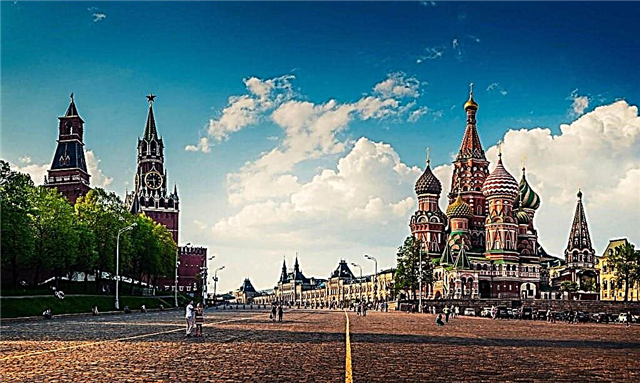While you are reading these lines, somewhere far away (or maybe not so far away), silent seas murderers hiding beneath the water column plow the seas. They are huge, powerful and deadly, capable of lurking for months in the depths, one day to deliver a decisive blow.
No, it's not about the new horror movie and not about the documentary video "from the life of sharks." In this article, dear readers, you will find the answer to the question which submarine is worthy of being the largest in the world, and which countries can afford to build such steel giants.
And more recently, we introduced readers to the 10 largest ships in the world.
10. Astyut - length: 97 m, width 11.3 m
 The tenth largest submarine in the world is the largest, most advanced and most powerful of the submarines ever operated by the Royal Navy of Great Britain. Its size is 97 meters long and 11.3 meters wide.
The tenth largest submarine in the world is the largest, most advanced and most powerful of the submarines ever operated by the Royal Navy of Great Britain. Its size is 97 meters long and 11.3 meters wide.
The Astyut class includes three submarines, and four more are under construction. In case you have to join the battle, the submarine is armed with six 48 missiles or torpedoes, Tomahawk cruise missiles, Harpoon anti-ship missiles and 533 mm torpedo tubes.
In 2012, Astyutes proved their ability to launch Tomahawk missiles by successfully firing two missiles from the Gulf of Mexico and accurately hitting targets at a test site in North Florida.
9. Sivulf - 107.6 x 12.2 m
 This series of nuclear submarines was built by order of the US Navy in 1989-1998. The Sivulfs were a response to the construction of submarines in the Soviet Union under project 971 Schuka-B. In total, three ships were built, although it was originally planned that the series would include 12 submarines.
This series of nuclear submarines was built by order of the US Navy in 1989-1998. The Sivulfs were a response to the construction of submarines in the Soviet Union under project 971 Schuka-B. In total, three ships were built, although it was originally planned that the series would include 12 submarines.
The length and width of the Sivulfs hull are 107.6 meters and 12.2 meters, respectively. These submarines are equipped with one nuclear reactor, and their speed is 18 knots.
The armament mounted on an American submarine includes eight 660-mm torpedo tubes, 50 torpedoes or missiles, and 50 Tomahawk cruise missiles.
8. Project 945A "Condor" - 110.5 x 12.2 m
 The first, but not the only among the largest submarines in Russia. To date, two “Condors” are in operation, with a length of 110.5 meters and a width of 12.2 meters.
The first, but not the only among the largest submarines in Russia. To date, two “Condors” are in operation, with a length of 110.5 meters and a width of 12.2 meters.
The hull of the Condor class submarines is made of light and durable titanium, which allows the submarine to reach greater depths and reduces the noise level. From the armament, the Kondory boasts six 533 mm torpedo tubes, 40 torpedoes, S-10 Granat cruise missiles and 8 Igla-1 and Igla MANPADS.
7. Project 971 "Pike-B" - 110.3 x 13.6 m
 You can criticize the Soviet Union for a lot, but not for a weak army and navy. It was in the USSR that the construction of one of the largest nuclear submarines in the world, the Pike-B, was underway. Unlike the Condor, the hull of this submarine is made of alloy steel. The length of the formidable steel “fish” is just over 110 meters, and the width is over 13 meters.
You can criticize the Soviet Union for a lot, but not for a weak army and navy. It was in the USSR that the construction of one of the largest nuclear submarines in the world, the Pike-B, was underway. Unlike the Condor, the hull of this submarine is made of alloy steel. The length of the formidable steel “fish” is just over 110 meters, and the width is over 13 meters.
The Shchuki-B project (1983-2001) was carried out at the Sevmash machine-building enterprise in Severodvinsk and was revised several times. Improved boats were called by the Western military the “Improved Akula” (“Improved Shark”), or “Akula-II.” And the most modernized submarine - K-335 "Cheetah" - in the West was called "Akula-III." The Indian Navy is also armed with one of the upgraded Shchuk-B (K-152 Nerpa). It lacks the SOX system and the ability to launch acoustic countermeasures.
In 2017, four submarines of the Pike-B class remained in service. Each of them is equipped with four 650-mm torpedo tubes, four 533 mm TA, IRS Caliber-PL and MANPADS Strela-3M.
6. "Triumphan" - 138 x 12.5 m
 Sunny France is one of the few European countries that can afford the construction of a huge, heavy and expensive submarine. From 1989 to 2009, four submarines of the Triumphan class were built with a length of 138 and a width of 12.5 meters. It was originally planned to build six units, but the plans of the French Navy have changed due to the collapse of the Soviet Union.
Sunny France is one of the few European countries that can afford the construction of a huge, heavy and expensive submarine. From 1989 to 2009, four submarines of the Triumphan class were built with a length of 138 and a width of 12.5 meters. It was originally planned to build six units, but the plans of the French Navy have changed due to the collapse of the Soviet Union.
The Triumphans are armed with four 533 mm caliber torpedo tubes, 10 torpedoes, 8 Exocet SM39 cruise missiles launched from TA and missiles of the M45 and M51 types.
5. Wangard - 149.9 x 12.8 m
 The pride of the British fleet, with a length of over 149 meters and a width of more than 12 meters. The Vengard series includes four atomic submarines, the history of which began in the 90s of the twentieth century. They were built in a huge covered boathouse (workshop for construction or repair) with a length of 260 and a width of 58 meters. Its size allows you to build not only nuclear submarines, but also destroyers with guided missile weapons.
The pride of the British fleet, with a length of over 149 meters and a width of more than 12 meters. The Vengard series includes four atomic submarines, the history of which began in the 90s of the twentieth century. They were built in a huge covered boathouse (workshop for construction or repair) with a length of 260 and a width of 58 meters. Its size allows you to build not only nuclear submarines, but also destroyers with guided missile weapons.
Initially, it was planned to collect 6 or even 7 submarines, but with the collapse of the USSR, Great Britain and other NATO countries no longer needed a large number of submarines as a means of nuclear deterrence.
There are four 533 mm caliber TAs, 16 Trident II D5 ballistic missiles and Spearfish or Tigerfish remote-controlled torpedoes aboard the Vanguards.
4. “Delta” - 167.4 x 11.7 m
 Such is the collective designation of four types of strategic nuclear submarines assembled in the USSR at once. Project code names:
Such is the collective designation of four types of strategic nuclear submarines assembled in the USSR at once. Project code names:
- "Moray".
- Murena-M.
- "Squid".
- "Dolphin".
The length of the last modification - “Dolphin” - is 167.4 meters, and the width is 11.7 meters. This great steel fish was commissioned in December 1984. Of the seven Dolphins built, five are still listed in the Russian Navy.
Enemies of the “Dolphins” will not be greeted, because they are equipped with four 533 mm caliber TA, 12 torpedoes, 16 ballistic missiles and from 4 to 8 Igla and Igla-1 MANPADS.
3. "Ohio" - 170.7 x 12.8 m
 These giants are the largest submarines in the United States and the backbone of the US strategic offensive nuclear forces. They regularly have to carry out combat patrols, spending 60% of the time at sea. The size of "Ohio" is 170.7 meters and 12.8 meters (length and width, respectively).
These giants are the largest submarines in the United States and the backbone of the US strategic offensive nuclear forces. They regularly have to carry out combat patrols, spending 60% of the time at sea. The size of "Ohio" is 170.7 meters and 12.8 meters (length and width, respectively).
The first submarine of this series was put into operation in November 1981. All other submarines received names in honor of the US states, with the exception of USS Henry M. Jackson, which was named after one of the senators.
These submarines are capable of carrying over twenty Trident II missiles and over 150 Tomahawk cruise missiles. Their armament also includes four 533 mm torpedo tubes.
2. Project 955 Borey - 170 x 13.5 m
 The second number in the list of the largest submarines is once again the Russian development, one of the most advanced in the world. The Borey project began in 2011, and in May 2018 it became known that by 2027 it was planned to build 14 ships of this type.
The second number in the list of the largest submarines is once again the Russian development, one of the most advanced in the world. The Borey project began in 2011, and in May 2018 it became known that by 2027 it was planned to build 14 ships of this type.
In the future, it is Borey that will replace the first and fourth numbers on our list.
The size of the submarine is 170 meters in length and 13.5 meters in width. This figured deadly beauty can go under water at a speed of 29 knots, and is equipped with six 533 mm torpedo tubes, six 324 mm sonar counters, torpedoes, torpedo missiles and cruise missiles (including Onyx and Caliber), as well as 16 PU complex "Bulava".
1. Project 941 "Shark" - 172.8 x 23.3 m
 Known to the West as the Typhoon class, and to the Russian sailors as the Shark, these majestic steel giants were created to counter American Ohio class submarines during the Cold War.
Known to the West as the Typhoon class, and to the Russian sailors as the Shark, these majestic steel giants were created to counter American Ohio class submarines during the Cold War.
Being 172.8 meters long and 23.3 meters wide, these monsters above and below 23,200 tons and 48,000 tons respectively, were larger than competing U.S. submarines. Their height (26 meters) is comparable to the height of a nine-story building.
In fact, the task of the Sharks was to create a nuclear apocalypse in the West if the Cold War would go into the hot phase.
 The largest atomic submarine in the world got its predatory nickname thanks to the image of a shark that was painted before the first launch, which took place in September 1980.
The largest atomic submarine in the world got its predatory nickname thanks to the image of a shark that was painted before the first launch, which took place in September 1980.
 Inside the light hull of a huge submarine are five inhabited hulls. In an emergency in one of the hulls, the crew inside the other hulls will be safe and the assistive devices will still work.
Inside the light hull of a huge submarine are five inhabited hulls. In an emergency in one of the hulls, the crew inside the other hulls will be safe and the assistive devices will still work.
The two nuclear reactors provide these strategic submarines with the power they need to reach a maximum speed of about 25 knots underwater.
 Instead of constantly moving around the world’s seas and oceans, the “Sharks” were created to stay north of the Arctic Circle for six months, waiting for the team to launch their “farewell greetings to the world” - ballistic missiles R-39 “Option”.
Instead of constantly moving around the world’s seas and oceans, the “Sharks” were created to stay north of the Arctic Circle for six months, waiting for the team to launch their “farewell greetings to the world” - ballistic missiles R-39 “Option”.
Due to the length and nature of its missions, this Soviet nuclear submarine missile cruiser was designed with crew comfort in mind. In fact, the living quarters on the Sharks were so luxurious that the sailors of the Soviet (and then Russian) navy called these gigantic ships the “floating Hilton”.
 Instead of utilitarian steel furniture with minimal upholstery, the Shark’s interior includes comfortable soft chairs, full-sized doorways, a fully equipped gym, a swimming pool with fresh or salt sea water, a solarium and even a sauna, the walls of which are covered with oak boards. The command cabins have televisions, sinks and air conditioning.
Instead of utilitarian steel furniture with minimal upholstery, the Shark’s interior includes comfortable soft chairs, full-sized doorways, a fully equipped gym, a swimming pool with fresh or salt sea water, a solarium and even a sauna, the walls of which are covered with oak boards. The command cabins have televisions, sinks and air conditioning.
However, the triumph of the huge and formidable Sharks did not last long. Of the seven planned submarines, six were built during the 1980s and retired less than 10 years later, in the 1990s. The Russian government simply could not afford to keep these largest missile submarines in the world in operational condition.
 Currently, only one modernized Shark - TK-208 Dmitry Donskoy - is in operation. The largest submarine in the world serves as a testing ground for modern ballistic missiles deployed on submarines (SLBM Bulava).
Currently, only one modernized Shark - TK-208 Dmitry Donskoy - is in operation. The largest submarine in the world serves as a testing ground for modern ballistic missiles deployed on submarines (SLBM Bulava).











